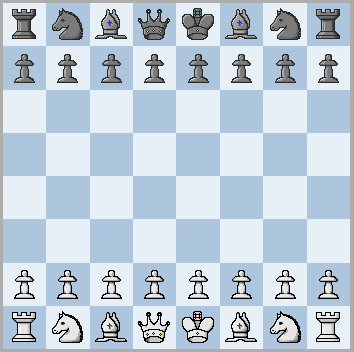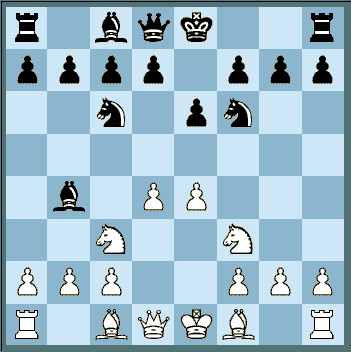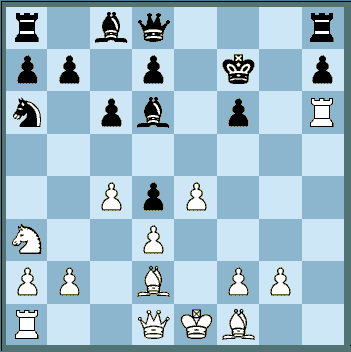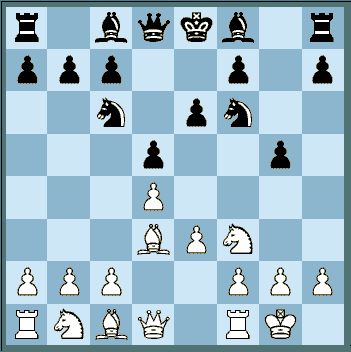

In Hopper Chess the objective is checkmate. Normal chess rules apply except for the following. Any piece (not pawn) situated in front of any friendly piece (including pawns) can use the latter as a springboard for hopping over an enemy pawn standing on the same file, provided that there are no pieces in between. The piece lands immediately behind the enemy pawn. Note that the King can also make such jumps.
This piece movement is logical as the pawn chain functions similarly as a palisade. How to overcome such hindrances has always been a tactical problem in wartime, and is a notorious problem in chess. This chess variant introduces a new technique of solving this problem. The hop move will often be used to create threats that must be warded off. It opens up new and interesting tactical possibilities during all phases of the game. One such possibilty is to temporarily hinder the opponent's castle. Pieces that fulfil the requirements for making a hop are referred to as hoppers, e.g., "a knight-hopper at f3".
The war tactics of hopping over palisades, or climbing over a defensive wall during siege, is reflected in this game. For instance, pole vault is a branch of athletics that developed out of a technique for hopping over palisades and other hindrances in war.
Remember that two heavy pieces (Queen and Rooks) placed adjacent to each other on a file is now become a deadly weapon, while a pawn chain cannot easily ward them off. The King can no longer feel fully safe behind his pawns. In the endgame the King can often become very active thanks to the new hop move. It's not easy to shut the enemy King out by closing the position. Another curious detail is that the King can give check to the enemy King by long distance. But this works fine. Despite these differences, the laws of chess are much the same in Hopper Chess as in regular chess.
Examples
 In this position white played 5.d5 which is refuted tactically: 5...exd5 6.exd5 Nxd5! 7.Qxd5 Bxc3+ and if white now takes with the pawn 8.bxc3 then follows the devastating hop move 8...Nxc2+
In this position white played 5.d5 which is refuted tactically: 5...exd5 6.exd5 Nxd5! 7.Qxd5 Bxc3+ and if white now takes with the pawn 8.bxc3 then follows the devastating hop move 8...Nxc2+
 In this position white continued the attack in this effective way 12.Qh5+ Kg7 13.Rxh8 (hop move) 13...Kxh8 (13...Qxh8? 14.Bh6+ and black will lose the queen by a hop move) 14.Bh6+ this is a "hop check" 14...Kg8 15.Qg4+ Kf7 16.Qg7+ etc.
In this position white continued the attack in this effective way 12.Qh5+ Kg7 13.Rxh8 (hop move) 13...Kxh8 (13...Qxh8? 14.Bh6+ and black will lose the queen by a hop move) 14.Bh6+ this is a "hop check" 14...Kg8 15.Qg4+ Kf7 16.Qg7+ etc.
 Black has just started an attack on the king's wing by 5...g5 and now white can't play 6.Nxg5? because then follows the hop move 6...Nxf1 and black is winning.
Black has just started an attack on the king's wing by 5...g5 and now white can't play 6.Nxg5? because then follows the hop move 6...Nxf1 and black is winning.
There is also a variant that features Scorpion pawns (see Scorpion Chess). The Scorpion has the additional moves of a knight, but only in two forward directions: east-north-east, and west-north-west. There are no additional capture moves.The Scorpion's value is half the value of a knight or bishop, that is, 1.5. This means that a light piece can be exchanged for two Scorpions, a possibility which often occurs. In the endgame it could become very dangerous, and its value often increases.
• You can download my free Hopper Chess program here, (updated 2006-07-02) but you must own the software Zillions of Games to be able to run it.
• Try playing Hopper Chess by e-mail, against a human opponent, here.
• or try the same variant with Scorpions, here.
• Don't miss my other chess variants.
© M. Winther 2006